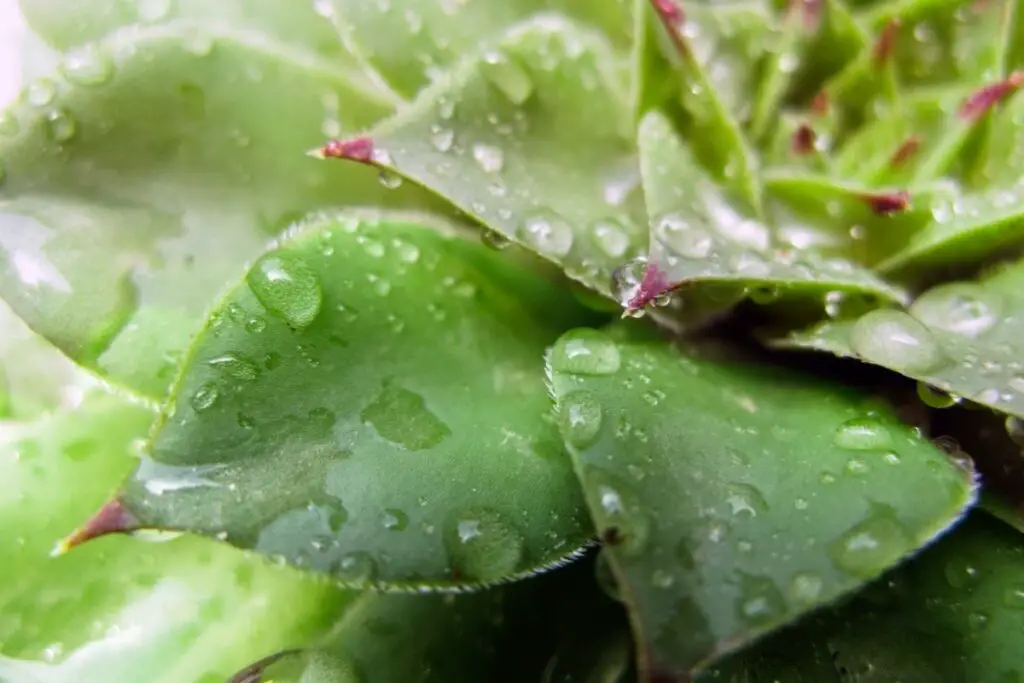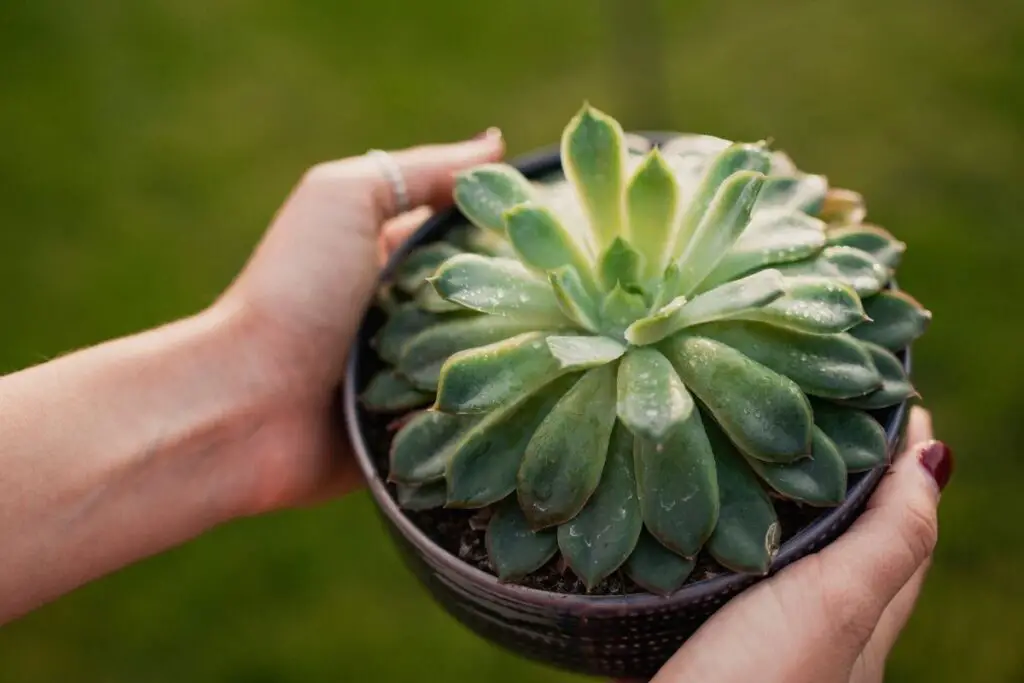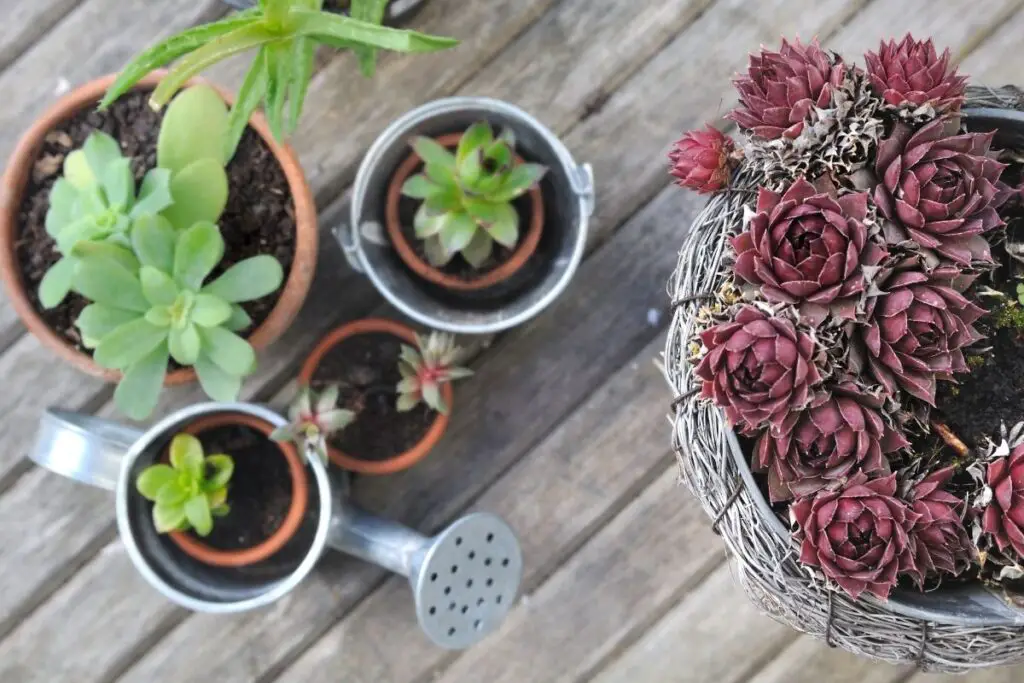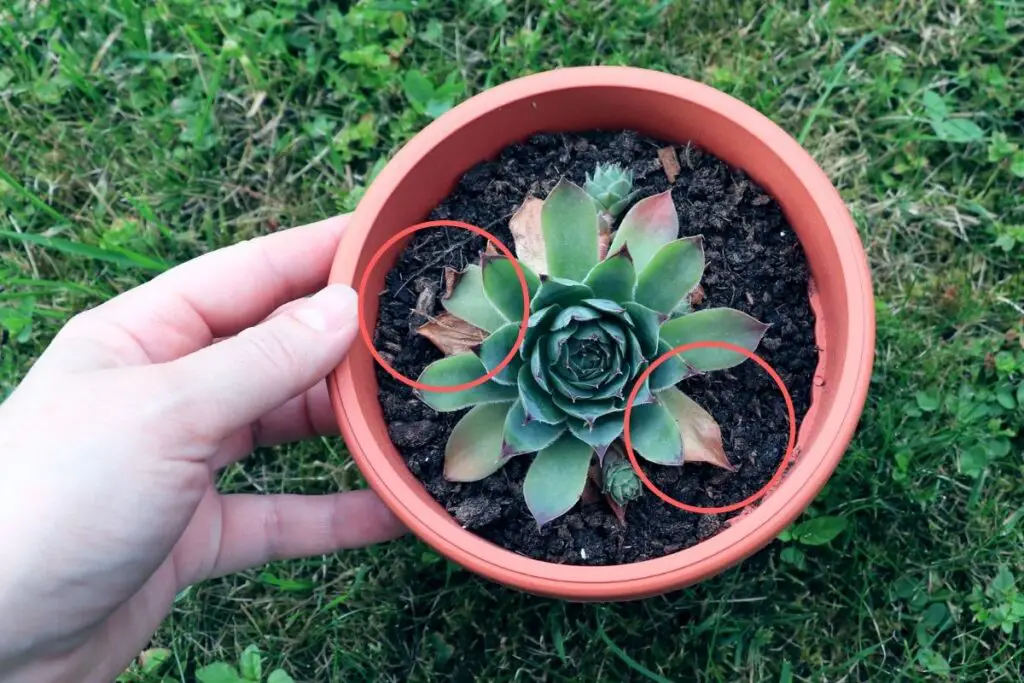Hens and Chicks are hardy and lovely succulent plants. They ought to remain healthy with less amount of water than other plants. Most succulents, including Hens and Chicks, are drought-tolerant plants. But that doesn’t mean you don’t need to water them at all.
Hens and chicks do need correct watering to remain healthy so, in this article let us learn how much water do hens and chicks need.
Generally, Hens and Chicks will require watering once a week during hot or dry weather and biweekly during the winters. The correct way of watering is checking the soil first and watering the plant if the soil feels dry. Always skip the watering for a few days if the soil is moist.
One cannot confirm the amount of water needed for Hens and Chicks. You have to adjust the frequency depending on the various factors influencing the watering requirements.
If you are unsure about watering your Hens and Chicks, this article will deliver all the details to help you understand and learn about the ideal watering method for this plant. We will also explain underwatering and overwatering issues and their fixation.

How often to water the Hens and Chicks?
The watering frequency is difficult to confirm in the case of Hens and Chicks. Without knowing the factors affecting watering, it is impossible to answer this question.
But, if you ask on an average rate, then I would say that Hens and Chicks generally need to be watered once every week. However, that too can be skipped if your region receives rainfall.
Hens and Chicks can tolerate droughts, but they cannot withstand overwatering. Though, the watering routine of the potted Hens and Chicks is quite different from the outdoor Hens and Chicks.
The indoor ones need water more often than the outdoors. This somewhat depends on the pot type.
Hens and chicks water requirements
Hens and Chicks need watering primarily during the dry seasons. As they are drought-resistant plants, they don’t need much watering in other seasons.
Try checking the moisture level of the soil. When the topsoil dries out for more than an inch, you can water the plant.
Below I have noted some factors which concern the watering of the Hens and Chicks:
Looking for gardening supplies? We have tested 100's of products before recommending them to you guys. Check out our best pick below:
| Image | Gardening Supplies | Best Price? |
|---|---|---|
 Top
Top Top
Top | Raised Garden Bed Kit | Check On Amazon |
 | XLUX Soil Moisture Meter, Plant Water Monitor, Soil Hygrometer Sensor for Gardening, Farming, Indoor and Outdoor Plants, No Batteries Required | No Results |
 Top
Top Top
Top | 82 Pcs Garden Tools Set and Extra Succulent Tools Set | Check On Amazon |
 | Joeys Garden Expandable Garden Hose with 8 Function Hose Nozzle, Lightweight Anti-Kink Flexible Garden Hoses, Extra Strength Fabric with Double Latex Core, (50 FT, Black) | No Results |
 Top
Top Top
Top | Dual Chamber Compost Tumbler | Check On Amazon |
 Top
Top Top
Top | Sunnyglade Plant Stakes | Check On Amazon |
 Top
Top Top
Top | Organic Cold Pressed Neem Seed Oil | Check On Amazon |
 Top
Top Top
Top | Mighty Mint Gallon :-Insect and Pest Control Peppermint Oil | Check On Amazon |
 Top
Top Top
Top | Scotts DiseaseEx Lawn Fungicide | Check On Amazon |
 Top
Top Top
Top | Jacks Classic 20-20-20 All Purpose Fertilizer | Check On Amazon |
 Top
Top Top
Top | 30,000 Seeds Pollinator Attracting Wildflower Mixture | Check On Amazon |
 Top
Top Top
Top | Survival Vegetable Seeds Garden Kit-Over 16,000 Seeds | Check On Amazon |
Time of the year
The watering frequency depends on the current time of the year. Is it summer or winter? Is it spring or autumn? All of it will have a diverse watering schedule.
Spring
When spring arrives, the climate starts heating up. At this time, you will have to water the plant more than in winter. But don’t overwater.
Spring is the beginning of their growing season. So, you need to provide them with the correct watering to let them thrive.
If you have planted your Hens and Chicks in sandy soil, water them once a week. If the soil is clayey, you don’t need to water them frequently. The soil will have enough moisture to keep the plant healthy.
Summer

The Hens and Chicks will need more water in summers than in other seasons. That doesn’t mean you need to soak them in water.
The soil dries out very quickly when the summer arrives. The sunlight gets severe, and there is barely any rain. So watering them correctly to keep the soil bed moist is vital.
They will indeed be able to endure drought, but not for long. During the summers, the soil will dry out very quickly.
The Hens and Chicks need to be watered twice a week, especially if they are planted in sandy soil. Clayey soil tends to retain moisture for a long time.
You can water them once or twice a week, depending on the soil moisture. Check the moisture before watering.
Autumn
When autumn arrives, the climate slowly starts cooling down, and the days get shorter. The Hens and Chicks will slowly part from active growth and move towards dormancy.
When the plant goes dormant, they stop growing and don’t need water or fertilizer.
Once autumn arrives, you need to reduce watering gradually. Moreover, it is time when rainfall will occur periodically. So you can even skip watering for a few days during rainfall.
The exception is when the sun is still warm at the beginning of autumn.
The soil will dry up and will require watering. Water them once a week if grown over sandy soil. Don’t use too much water, just enough to keep the soil moist.
Winter
Stop frequent watering in winter. They become dormant and don’t grow.
In the winters, the intensity of the sunlight is relatively low than in other seasons, and the soil doesn’t quickly get dry. Altogether, this makes frequent watering unnecessary for Hens and Chicks.
You can check the soil biweekly and water the plant only if the soil feels dry.
Watering depends on the type of soil.
The soil type also plays a significant role in the watering frequency for Hens and Chicks. Sandy soil dries very quickly, whereas clayey soil takes a lot of time to dry out completely.
Using sandy soil for the Hens and Chicks is better because they are drought-tolerant plants and won’t enjoy prolonged wet conditions.
But if you have planted these plants in clayey soil, they will not need much watering the whole year, other than summer.
Sandy soil loses moisture too fast. That is why they need watering at least once a week during spring and autumn, twice a week in summer (in the case of no rain), and no water during winter.
You can gradually stop watering from the second half of the autumn season. As they will enter winter, they will need significantly less water.
Watering will depend on the plant’s size.

The size and shape of the Hens and Chicks will affect the amount of water consumption. Usually, the large plant varieties will need more water.
But, the bigger ones can hold moisture much better than the dwarf varieties. So, even though they need more water, they don’t need water more often.
Watering them once a week very well during drought seasons will keep them healthy for the long term.
The plant has its moisture-holding ability and will not need much watering. If you think that being big, they need more water in summers, you are wrong. That will only result in overwatering and other diseases.
The dwarf varieties will not need more water because they are small, of course. They grow pretty slower than the bigger varieties. By small varieties, I mean the dwarf Arachnoideum and Globiferum.
But they will need water more often than the large ones. Use less water but more frequently, especially when the soil dries out quickly.
The young plants also need special care at the time of watering. They are yet to develop strong roots. They will die if separated from their mother and given too much water.
Separate the plant from its mother plant when it develops its first roots. Transplant the small one in a new bed and water in less amount.
With small amounts, water them every 2 to 3 days. Once they start growing big, increase the amount and decrease the frequency.
Underwatering and overwatering
These two are the most typical troubles when watering the Hens and Chicks. Even though underwatering can be resolved faster, overwatering takes time to recover.
Underwatering will not kill the plant unless it is too long, but overwatering will kill the plant within weeks. So, while watering, you need to be very careful.
Let’s discuss these two in brief so that you can fix and prevent them as well.
Underwatering
Hens and Chicks can tolerate drought conditions but not for long.
Keeping them dry for a very long period can kill them from dehydration. When the plant is thirsty, certain signs indicate the water requirement.
The signs are visible on both large and dwarf varieties, the former showing more.
Signs:
- Dry and crispy leaves
- Wrinkled leaves
- They turn limp
- The rosettes of small varieties don’t open.
- Their sizes are much small than usual.
- The dwarf species of the plant face more difficulty in tolerating underwatering than the big ones because the big ones can hold moisture in them.
- Still, the big ones will look dull and won’t have daughter plants.
How to fix underwatering?
When you see the signs of underwatering, immediately water them to make the soil moist so that the plant retains back moisture. This happens mainly during the summers.
Water the Hens and Chicks 1 or 2 times a week to avoid underwatering. Constant check on the moisture level will help in preventing underwatering.
For a healthy plant, moderate watering is essential.
Overwatering

You can save Hens and Chicks from underwatering with alterations in watering. But in overwatering, it becomes tough to bring the plant back to life. It will become weak and stressed out.
Overwatering mostly happens when the weather starts getting cold in the second half of autumn or winter. In the autumn, stop the watering gradually once the temperature in your area starts dropping.
In the cold weather, the plant stops growing and won’t accept any water. Watering the plant will only accumulate the water and suffer from overwatering.
Another circumstance when overwatering takes place is during late summer and early fall. The weather remains cold and frequent rains are expected. During rainy days, you should skip watering until the top 1 to 2 inches of topsoil feels dry.
Signs of overwatering:
- Yellow leaves
- It starts rotting and looks very dull.
- The socket in the middle starts getting soft.
- Leaves start falling off.
- The plant gets longer.
- Overflow will cause root rot. Root rot makes it more challenging to save the plant.
How to fix overwatering?
First of all, you just need to stop watering.
When you see the initial signs, dig up the plant and take it to a dry location. Remove the soil from the roots and if any rot is present, remove that too. This will prevent the rot from spreading.
Use a fungicide solution to cure the plant. Let it dry.
It is better to bring it inside if the reason is frequent rains. You can control the plant’s overwatering conditions and save it from overflow.
If you want to keep it outside, place it in dry soil and create a shelter to save them from any further rain overflow.
Water the plant very carefully. Let the soil dry before watering.
If the variety needs full sun, let it have the sun when it arrives. This can dry out the soil faster.
What do I do to avoid it?
Plant the Hens and Chicks in sandy soil, especially the large varieties. They can retain moisture in themselves. Sandy soil will help in good water drainage. Try other ways too to improve drainage.
If 1 to 2 inches of topsoil gets dry, water the plant. Follow a proper watering regime to save it from overwatering. Don’t water more than 2 times, even in dry weather.
Final thoughts
Watering plants is straightforward yet risky. Following a proper watering routine and becoming proficient in it takes a long effort and time. Even expert growers make mistakes. But with daily practice, you can improve.
Always keep the soil’s moisture level in check. When the top 1-2 inches get dry, you can water your Hens and Chicks.
The large varieties of the plant will need more water but less frequently. They can hold moisture. But the small ones need less water more frequently.
In the summers, water them twice a week. In the spring and autumn, once a week, skip during rains and don’t water in winter.
That’s all you need to remember. I have explained other tips in the article. Read them to succeed in growing Hens and Chicks.
It is not at all difficult to care for Hens and Chicks. They are effortless to grow, and being succulents, they will even tolerate drought to some extent. Just make sure not to overwater them ever, and you will see them thrive in your garden.
Reference: Wikipedia, Iowa State University of Science and Technology, The University of Arkansas Division of Agriculture, NSDU, The Ohio State University, Missouri Botanical Garden.
